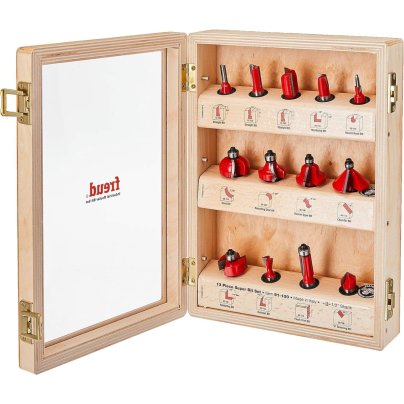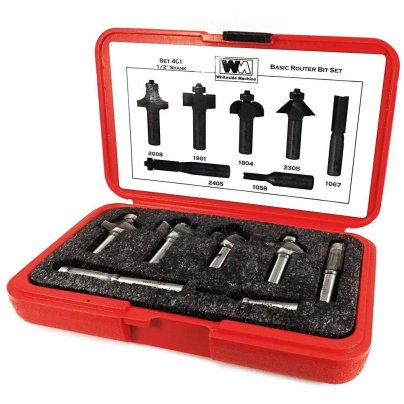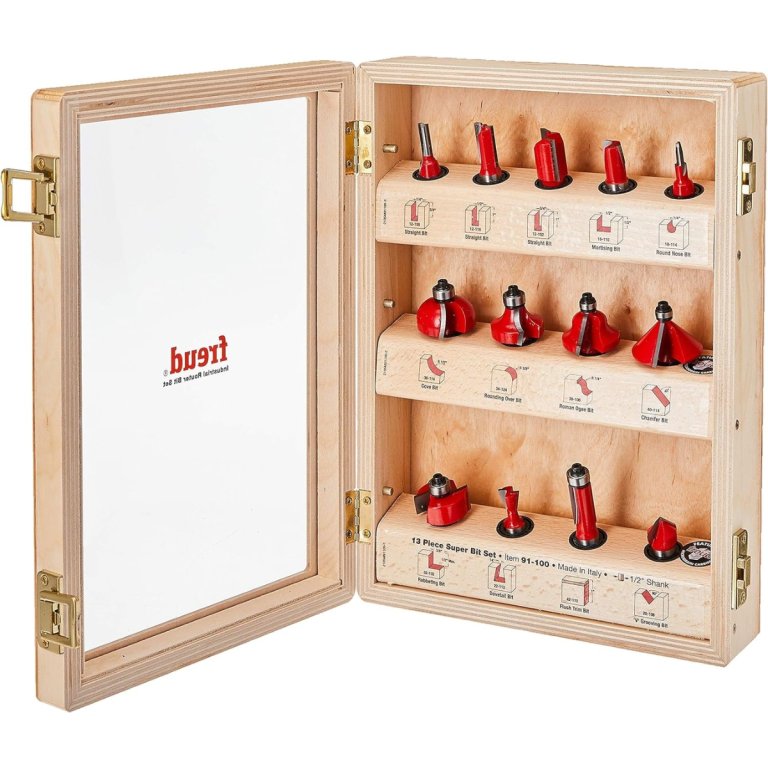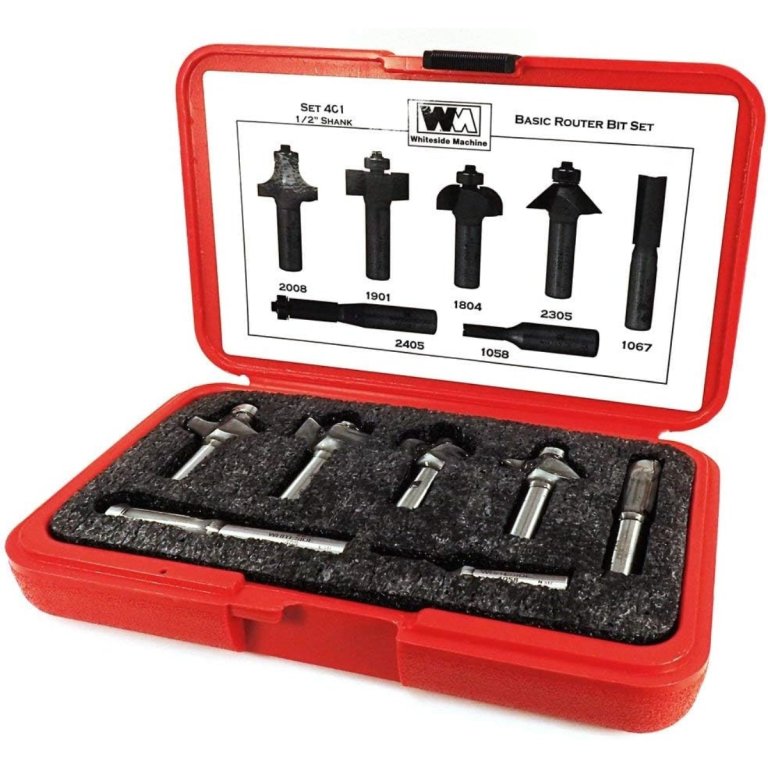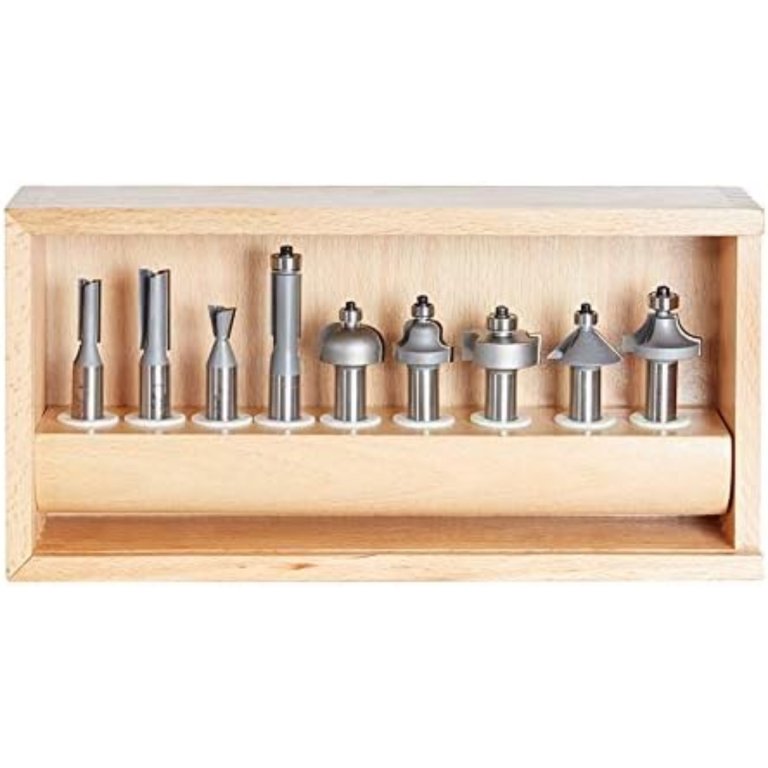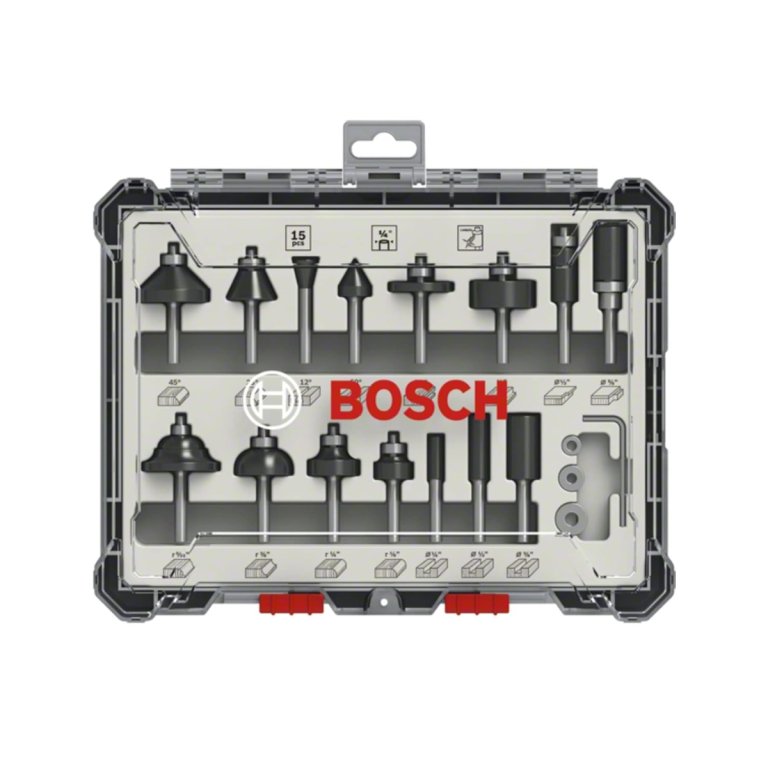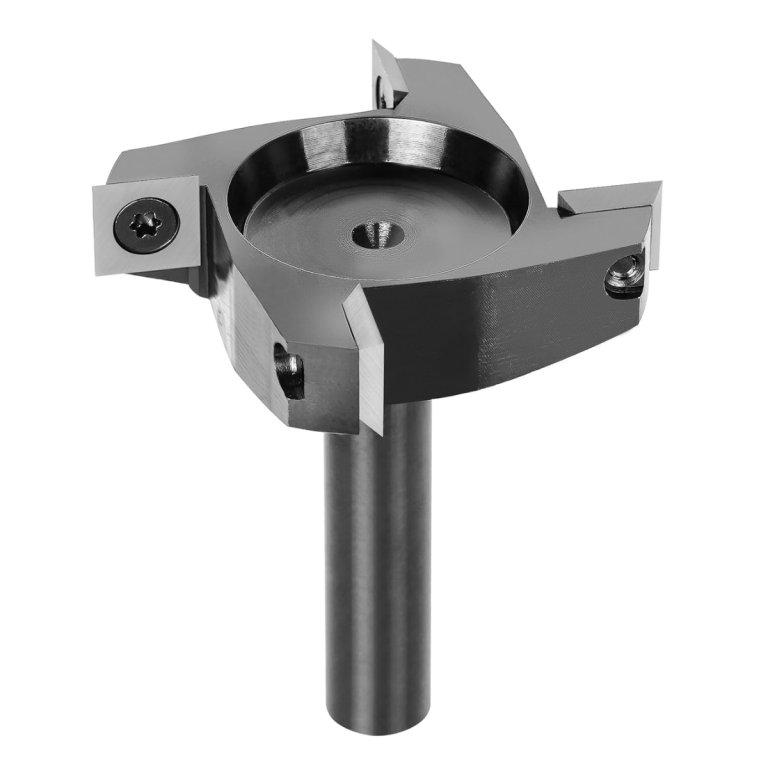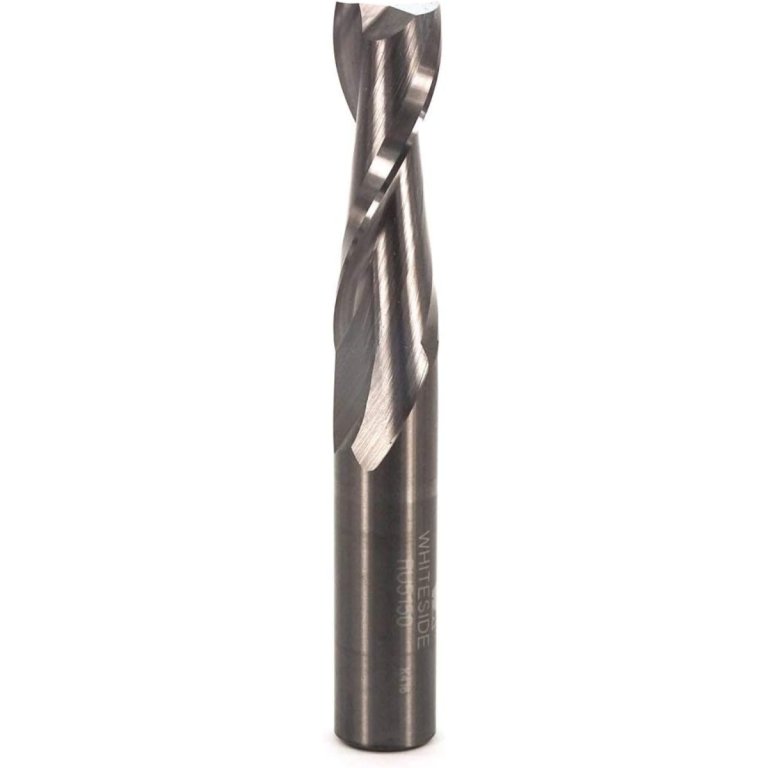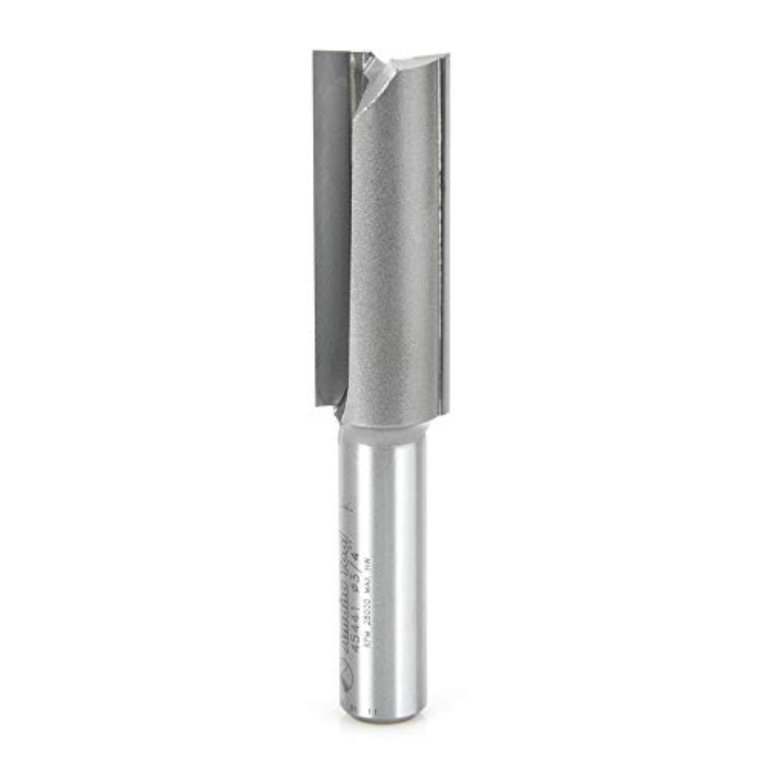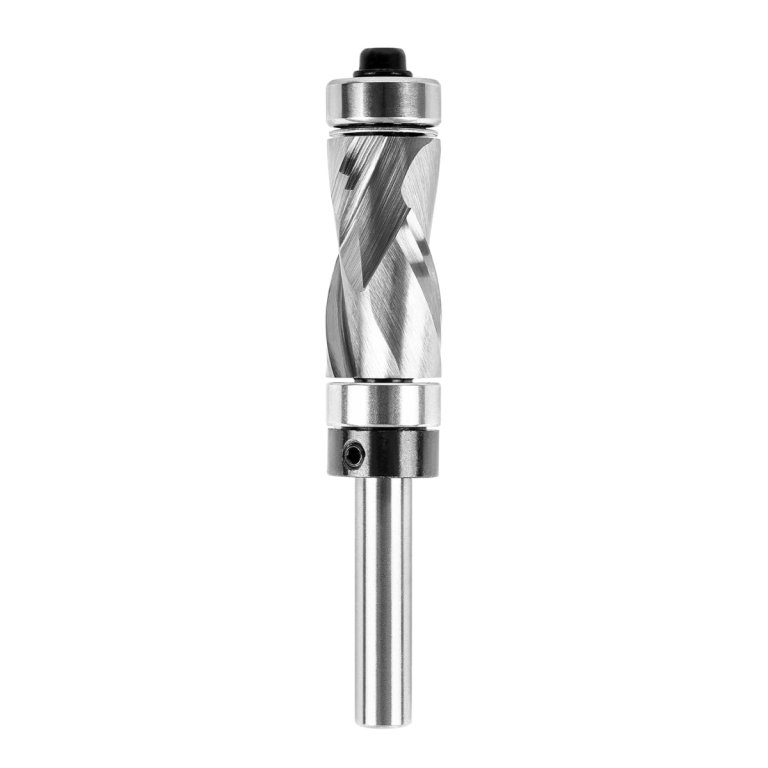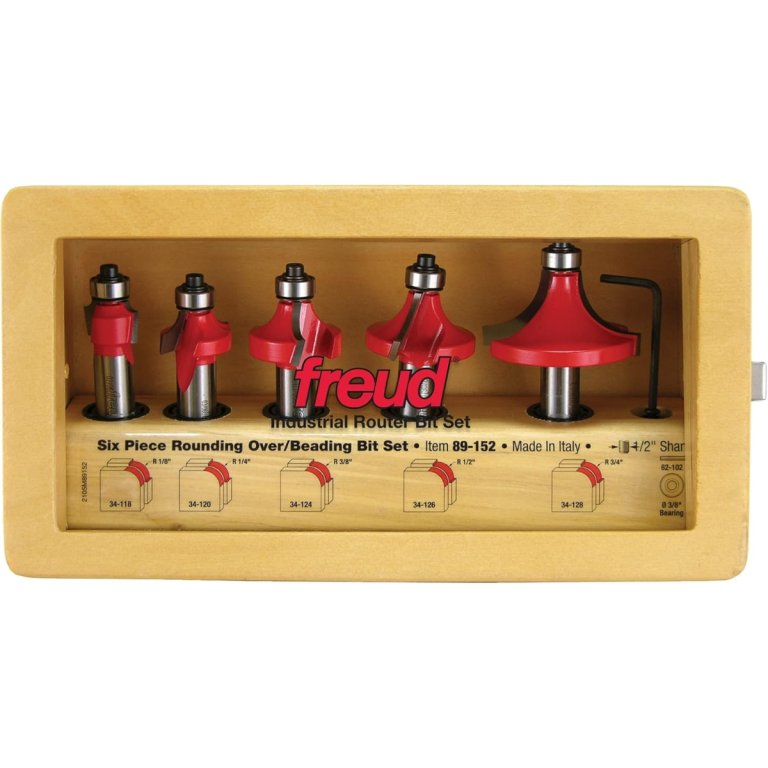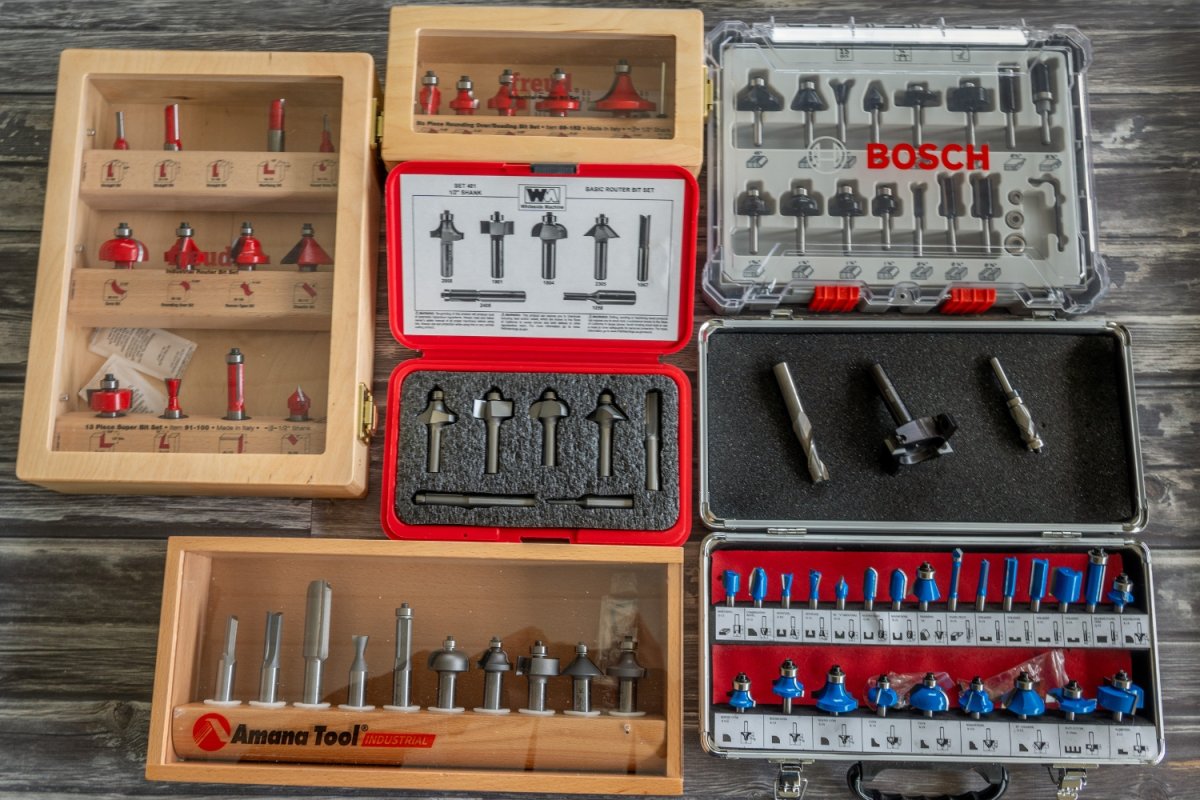
We may earn revenue from the products available on this page and participate in affiliate programs. Learn More ›
A router can be one of the most valuable tools for woodworking projects, but not without a set of high-quality router bits. Different types of bits let you use a router tool for joinery, edge forming, decorative grooving, and much more. With hundreds of router bit types to choose from and scores of manufacturers producing them, research and shopping could take up an inordinate amount of time that would be better spent making things. That’s why we spent a week testing 77 router bits from seven of the best tool makers in the business. In this guide, we will explain the research and shopping considerations we used to narrow our list and share our observations from testing.
Our favorite is the Freud 13-Piece Super Bit Set because it contains an assortment of the most commonly used bit profiles for grooving, joinery, and edge shaping. The bits feature premium carbide cutters for an extended working life and ½-inch shanks that fit securely into most routers. But that kit may not be right for your particular needs, which is why we tested a variety of options. Be sure to check out the full list to find the best router bits for your workshop.
- BEST OVERALL: Freud 91-100 13-Piece Super Bit Set
↓ Jump to Review - BEST BANG FOR THE BUCK: LU&MA 24-Piece Carbide-Tipped Router Bit Set
↓ Jump to Review - BEST FOR BEGINNERS: Whiteside Machine Company 401 Basic Router Bit Set
↓ Jump to Review - BEST PROFESSIONAL: Amana Tool AMS-211 9-Piece Carbide-Tipped Router Set
↓ Jump to Review - BEST FOR TRIM ROUTER: Bosch 15-Piece Mixed Router Bit Set
↓ Jump to Review - BEST FOR FLATTENING SLABS: SpeTool Spoilboard Surfacing Shank Router Bit
↓ Jump to Review - BEST FOR CUTTING CIRCLES: Whiteside Machine Company RU5150 Up Cut Spiral Bit
↓ Jump to Review - BEST FOR JOINTING: Amana Tool 45441 Carbide-Tipped Straight Plunge Bit
↓ Jump to Review - BEST FLUSH TRIM: SpeTool Carbide Compression Flush Trim Router Bit
↓ Jump to Review - BEST ROUNDOVER: Freud 89-152 5-Piece Round Over Router Bit Set
↓ Jump to Review
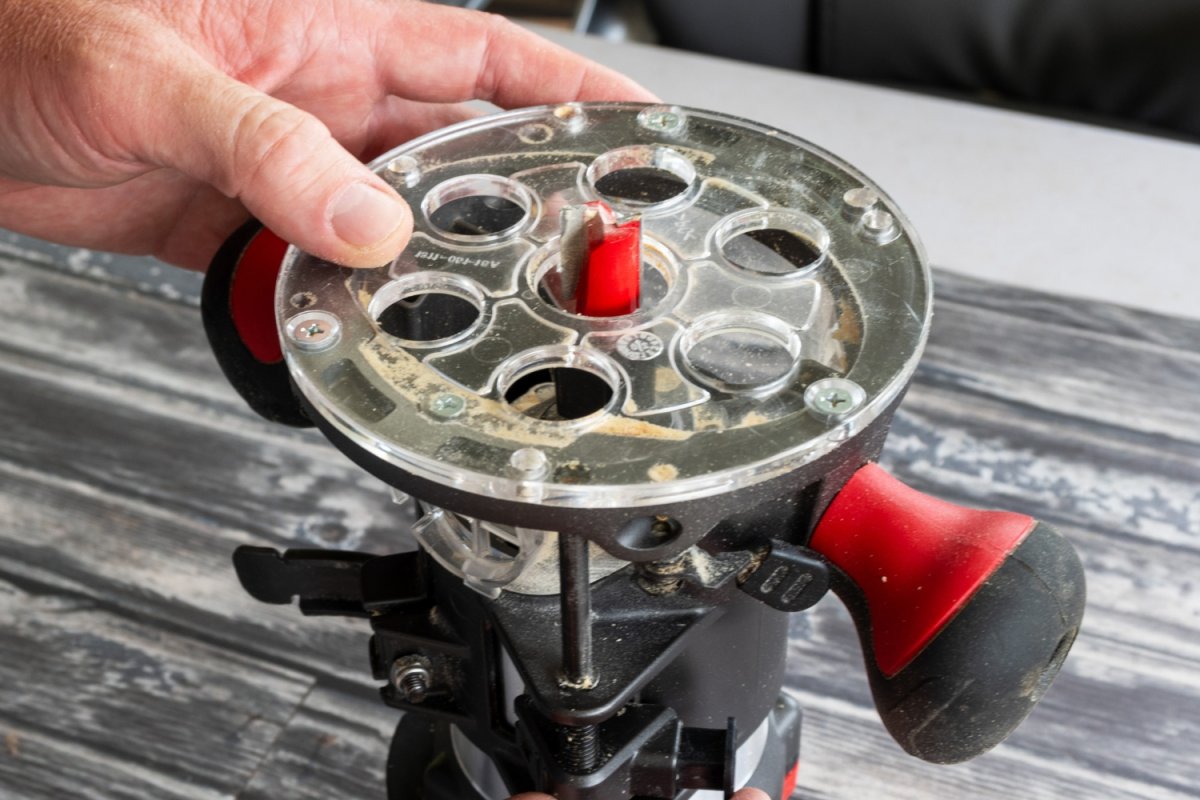
| Testing Stats | |
| Products Tested | 10 |
| Time Spend Testing | 11 |
| Tests Performed | 5 |
| Price-per-bit range | $1.50 to $60 |
Our Top Picks
After sifting through scores of router bits from top tool makers, we spent several days testing our picks. In the reviews ahead, we lay out our case for each selection, including the strengths and weaknesses we uncovered during testing. We hope you will use these observations as you decide which of these may be the best router bits for your workshop.
Best Overall
Freud 91-100 13-Piece Super Bit Set
What We Like
- Great selection of the most common profiles
- Excellent performance in hardwood and softwood
- Good grip and balance with no chatter
- Includes a hinged and indexed wooden storage case
What We Don’t Like
- Difficult to remove bits from case
- Not compatible with trim routers
Product Specs
- Material: High-density carbide
- Shank size: ½ inch
- Pieces: 13
Our Ratings: Cut Quality 5/5; Durability 5/5; Value 5/5
The best wood router needs a variety of router bits. You can either buy one at a time to avoid wasting money on bits you’ll never use or start with a general-purpose router bit set and add on as needed. If you buy into the second option, as we do, then the Freud 13-piece Super Bit set is an excellent choice. This set offers a mix of 13 high-quality ½-inch router bits for grooving, jointing, trimming, and shaping. Considering that this set includes a variety of straight, mortising, round nose, cove, roundover, Roman ogee, chamfer, rabbeting, dovetail, flush trim, and v-groove bits, it’s a purchase that will also save quite a bit of money compared to buying each one separately.
The Freud router bit set comes packaged in an indexed shadow box case that can be hung on a wall or mounted on a tool bench. The bits are suitable for cutting all composition materials, including softwoods, hardwoods, and plywood. The cutters’ perma-shield nonstick coating reduces blade drag and protects them from pitch buildup and corrosion. They work with conventional handheld and table routers.
To be fair, all of the ½-inch wood router bits we tested did a fantastic job in our tests. The Freud bits produced smooth, clean cuts and low vibration in router table and handheld applications. It was difficult to discern functional differences between Freud, Amana, and Whiteside router bits in the same profiles in order to rank one above the others. Still, we selected this kit for the top spot for two reasons. First, it includes the best mix of bit profiles for beginners who are just starting out or for experts who have worn out some of their most commonly used router bits. Secondly, the $14.08 average price per bit was the best we could find for professional-quality ½-inch shank router bits.
Get the Freud 91-100 router bits at Amazon, Rockler, or WoodCraft.
Best Bang For The Buck
LU&MA 24-Piece Carbide-Tipped Router Bit
What We Like
- Assortment of routing bits for jointing, edging, grooving, and trimming
- Works with palm, trim, or conventional routers
- Rugged carry case with indexed bit holders
- Huge selection of bits for an affordable price
What We Don’t Like
- Bits sometimes slip in the ¼-inch collet in conventional routers
Product Specs
- Material: Tungsten carbide
- Shank size: ¼ inch
- Pieces: 24
Our Ratings: Cut Quality 5/5; Durability 4/5; Value 5/5
The LU&MA carbide-tipped router bit set includes a good variety of cutters for edging, grooving, and trimming for the lowest price-per-bit of our entire test group. This affordable tungsten-carbide router bit set comes packed in an indexed case for easy bit identification and organization. The ¼-inch shank bits work with conventional and compact routers, while the machine-sharpened tungsten carbide-tipped edges will help keep the bits sharper longer. When they dull, the bits can be resharpened to extend their working life even longer.
This set provides an incredible number of bits for the price. The average cost of $1.58 per bit might be a red flag for pros, but occasional users will most likely be completely satisfied. In our tests with a handheld trim router, the bits performed well. They produced minimal chatter and nice, clean cuts. However, we noted a variance from the product description: The carry case was made of aluminum and plastic instead of wood. The case indexing included the bit name, size in fractions, an image of the cut effect, and a profile image of the bit. But it was printed on paper and glued into the case, so you might consider replacing it with something more durable before the current one wears out.
Get the LU&MA router bits at Amazon, The Home Depot, or Walmart.
Best For Beginners
Whiteside Machine Company 401 Basic Router Bit Set
What We Like
- 7 high-quality woodworking router bits in the most popular profiles
- Includes a sturdy plastic case
- Durable carbide cutters
- Prelubed and safely packed with a protective coating
What We Don’t Like
- Not compatible with trim and palm routers
Product Specs
- Material: Carbide tip
- Shank size: ½ inch
- Pieces: 7
Our Ratings: Cut Quality 5/5; Durability 5/5; Value 4.7/5
For wood router beginners who are still learning how to use a router, a compact set of high-quality router bits could make the most sense. They will allow you to get comfortable, gain confidence, recognize your needs, and add more bits as needed. This small set of Whiteside router bits includes only seven bits, but the quality of the bits more than justifies the price. Each of the seven ½-inch shank bits is made of solid carbide instead of a carbide tip. There is no need to worry about a connection to a thin carbide tip that will eventually wear out. The entire bit can be relied on to cut smoothly and cleanly for a long time.
Although it only contained 7 bits, the Whiteside router bit set included options for basic shaping, jointing, pattern cutting, and grooving projects. Because of the limited number, we tested all but one of the bits for direct comparison against matching bits from Amana and Freud. The results were outstanding. The bits held securely in the collet without slipping, produced no unwanted vibration or chatter, and cut exceptionally well. We also liked the sturdy plastic carrying case, but since the case indexing only included a photo and bit model number, we added the bit profile names and dimensions.
Get the Whiteside Machine Company 401 router bits at Amazon, Holbren Precision Cutting Tools, or SkywayTools.com.
Best Professional
Amana Tool AMS-211 9-Piece Carbide-Tipped Router Set
What We Like
- Professional-grade carbide routing bits for wood
- ½-inch shanks add stability for precision cutting
- 9 of the best bit profiles for grooving, jointing, and shaping
- High-quality materials and construction
What We Don’t Like
- Sometimes mislabelled as an 11-piece kit; has 9 bits
- The case was not indexed
Product Specs
- Material: Carbide tip
- Shank size: ½ inch
- Pieces: 9
Our Ratings: Cut Quality 5/5; Durability 5/5; Value 4.7/5
To be considered professional quality, router bits have to work well out of the box and continue doing so long after the purchase; when the cutters finally dull, they must be resharpenable. The Amana Tool router bits feature thick, high-quality sub-micrograin and micrograin carbide cutters that allow for multiple resharpenings. The bit shaft and body are made from a single piece of solid bar stock, manufactured in a single clamping for superior symmetry, balance, precision, and centricity. The cutting tip is attached to the bit body using silver induction brazing that provides maximum carbide bonding strength. Finally, the shanks are laser etched with size, maximum RPM, and clamping depth.
The Amana router bits performed beautifully with smooth, balanced rotation; no chatter; and precise cuts. In our tests of six matching bits each, we were unable to verify a clear performance winner among Amana, Whiteside, and Freud router bits. We named Amana best for professionals because of the material and construction details, which indicate a longer expected working life after repeated resharpenings. In a surprising minor letdown, these bits, with arguably the best overall build quality, have a confusing naming convention. The model number and the product name indicate an “11-piece” set, but there are only nine bits in the set. Also, the nice wooden shadow box case has no index to indicate the bit profile shapes or dimensions, so we added those for our convenience.
Get the Amana Tool AMS-211 router bits at Amazon, Tools Today, or US Tool and Fastener.
Best For Trim Router
Bosch 15-Piece Mixed Router Bit Set
What We Like
- Good assortment of high-quality bits
- ¼-inch shanks work with compact trim routers
- Micrograin carbide tips for clean cuts and wear resistance
- Comfortable and smooth cutting action
What We Don’t Like
- General purpose kit may not include the exact bit you need
Product Specs
- Material: Carbide tip
- Shank size: ¼ inch
- Pieces: 15
Our Ratings: Cut Quality 5/5; Durability 5/5; Value 4.7/5
Compact trim routers and cordless routers require bits with smaller ¼-inch shanks, and Bosch makes some of the best. This set of 15 carbide-tipped router bits offers the benefits of precision cutting and durability. They feature premium micrograin carbide tips that have been heat-treated for an extra-fine finish and improved wear resistance. Fully hardened tempered steel shanks offer outstanding durability. These bits are designed with an anti-friction coating that minimizes residue buildup while working with softwoods, hardwoods, and wood composites.
In a side-by-side comparison with the other ¼-inch bits in our test group, the Bosch 15-piece mixed router bit set excelled. These bits offered the smoothest cutting ability and the least vibration of the group, both in handheld applications and when used in the router table. The cuts were consistently clean, and the bits resisted slipping in the collet.
Get the Bosch router bits at Amazon or Lowe’s.
Best For Flattening Slabs
SpeTool Spoilboard Surfacing Shank Router Bit
What We Like
- Specially designed for flattening/planing
- 4-sided replaceable cutters extend working life
- Durable, balanced design
- Includes router accessories: case and cutter changing tool
What We Don’t Like
- Does not include a set of replacement cutters
- Too large for efficient use in a router table
Product Specs
- Material: Carbide tip
- Shank size: ½ inch
- Pieces: 1
Our Ratings: Cut Quality 4.7/5; Durability 5/5; Value 4.3/5
Flattening natural wood slabs and CNC spoil boards requires a sharp, tough bit. Router bits like the SpeTool spoilboard surfacing shank router bit give woodworkers a clear path to consistently cleaner cuts and more precise flattening over the life of the bit. The 2½-inch diameter 4-wing bit is also perfect for trimming and grooving. This bit is equipped with four replaceable carbide cutters, each measuring 12 millimeters tall by 12 millimeters wide by 2.2 millimeters thick. Because all four edges are sharp, the cutters can be rotated four times for freshly sharp cutting edges. Once dulled after the fourth rotation, simply install a new set of cutter inserts. The universal bit works on hardwood, softwood, plywood, medium-density fiberboard (MDF), low-density fiberboard (LDF), fiberboard, and plastic.
In our tests, the SpeTool spoilboard flattening bit did a great job resurfacing several test boards, and it was easy to maintain. Because the extra-wide bit diameter made it dangerous and inefficient to use on the router table, we used a router sled for testing. After removing about ⅜ inch of weathered pallet wood surface, the result was smooth and ready for sanding. Although the cutters had not dulled noticeably, we rotated them for another cut and got similar results. The cutters held securely on the bit, and the bit held securely in the router. This router cutting bit offers excellent performance for a fraction of the price of similar bits from other brands.
Get the SpeTool spoilboard router bit at Amazon or SpeTool.
Best For Cutting Circles
Whiteside Machine Company RU5150 Up Cut Spiral Bit
What We Like
- Sharp, durable carbide cutter
- Well balanced, sturdy in the collet
- Up spiral removes chips from deep cuts
- Articulate; cuts smooth circles
What We Don’t Like
- Not compatible with compact routers
Product Specs
- Material: Solid carbide
- Shank size: ½ inch
- Pieces: 1
Our Ratings: Cut Quality 5/5; Durability 5/5; Value 4.7/5
When router cutting a circle in natural wood, as opposed to MDF or plywood, the bit cuts with the grain, across the grain, and against the grain in the same operation. That is the ideal scenario for the shear-cutting action of a spiral router bit, which makes the cleanest cut with the least risk of tearing. The Whiteside Machine Company up-cut spiral bit cuts clean and smooth in any direction to the grain and has the added advantage of removing chips from the groove, like a drill bit.
The solid carbide Whiteside bit made quick work of circle patterns we marked on oak, pine, and plywood scraps. The first three cuts were super clean around all of the edges and on the bottom surface. Then we plunged it through the bottom of the pine, which would have been impossible with a straight bit, and cut around again for a complete cutout. Again, the edges were super clean and neat. We appreciated the nimble agility, fast cutting, and repeatability this bit provided, even if it was a bit more expensive than other less capable options, such as a two-flute straight bit.
Get the Whiteside Machine Company RU5150 router bit at Amazon, Woodcraft, or Holbren Precision Cutting Tools.
Best For Jointing
Amana Tool 45441 Carbide-Tipped Straight Plunge Bit
What We Like
- Makes joints, grooves, dados, and mortises
- Durable solid carbide construction
- 2-fluted design for smoother cuts
- Sturdy, well-balanced ½-inch shank
What We Don’t Like
- Does not remove chips from enclosed cuts such as mortises
- Not compatible with compact routers
Product Specs
- Material: Carbide tip
- Shank size: ½ inch
- Pieces: 1
Our Ratings: Cut Quality 5/5; Durability 5/5; Value 4.7/5
The strongest types of wood joints require an edge with two flat faces at 90-degree angles. When using the router table as a jointer, a straight bit does the job nicely. The Amana Tool carbide-tipped straight plunge router bit features a two-fluted design for outstandingly clean edge cuts and a plunge tip that allows you to seamlessly switch from edge jointing to cutting mortise and tenon joints. The ¾-inch diameter and 2-inch cutting height make it a suitable option for use with a plunge router or a fixed-base router in most projects using hardwoods, softwoods, MDF, or plywood.
In our tests, the Amana Tool straight plunge router bit made perfect edges and clean groove bottoms in all of the test materials. The ½-inch shank prevented slipping in the collet, while the cutter quickly hogged out the material. As with the bits in the Amana bit set that we tested, this one made full, efficient use of the 2.5 horsepower router we used for testing. It worked fast and clean without sloppy chatter or vibration. Since most buyers probably have a storage system, this one comes in a simple throw-away plastic sleeve. If you are just getting geared up, the lack of a storage and protection solution could be problematic. That could be a good next woodworking project.
Get the Amana Tool 45441 router bit at Amazon, ToolsToday, or BallewSaw.com.
Best Flush Trim
SpeTool Carbide Compression Flush Trim Router Bit
What We Like
- Fits compact cordless or conventional routers
- Great for matching workpieces to templates
- Sharp, durable carbide cutter
- Top and bottom bearings
What We Don’t Like
- Best for cleaning edges after a rough cut, not a full cutout
Product Specs
- Material: Carbide
- Shank size: ¼ inch
- Pieces: 1
Our Ratings: Cut Quality 5/5; Durability 5/5; Value 4.3/5
One of the popular applications of flush trim router bits is cutting material to match a template. The SpeTool carbide compression flush-trim router bit includes several design features that make it an ideal choice for the job, whether the template is above or below the workpiece. The ¼-inch shank fits compact and conventional routers, while the ½-inch by 1-inch cutter is suitable for most projects using nominal 1-inch-thick material. Bearings at the top and bottom of the cutter offer maximum work flexibility.
One of the most unique benefits is the compression-pattern carbide cutting surface. The unique design cuts downward at the top and upward at the bottom, forcing chips toward the inside so that the upper and lower surfaces come out perfectly without splinters or fraying. This is especially helpful when cutting laminated pieces.
We went back to our circle cuts to test this bit. Where the previous cut made with the up-spiral bit was quite clean, it had a shear angle matching the taper of that bit. We wanted to square the edge to the surfaces. The risk of using a straight bit for the task is breakage upon encountering woodgrain running counter to the router’s direction. Using a trim router and a circle template ⅛ inch larger than the existing cut, in both top- and bottom-mounted configurations, the SpeTool compression flush trim bit delivered perfect results.
Get the SpeTool compression router bit at Amazon or SpeTool.
Best Roundover
Freud 89-152 5-Piece Round Over Router Bit Set
What We Like
- Sturdy ½-inch shanks and excellent centricity
- Kit includes router accessories: ⅜-inch bearing and hex key
- Includes 5 rounding over bits in the most popular sizes
- Durable carbide cutters work with any wood or composite material
What We Don’t Like
- Difficult to remove bits from case
Product Specs
- Material: High-density carbide
- Shank size: ½ inch
- Pieces: 5
Our Ratings: Cut Quality 5/5; Durability 5/5; Value 5/5
Rounding over is one of the most popular edging applications in woodworking, but different project dimensions call for larger or smaller profile diameters. The Freud five-piece round over router bit set has you covered. It includes five bits in ⅛-inch, ¼-inch, ⅜-inch, ½-inch, and ¾-inch cutting radii to tackle most small and midsize project needs.
In keeping with the brand’s reputation, this set offers excellent value. Each bit is computer balanced and precision ground for the smoothest possible cuts. The cutters are ready to work in rounding over applications, and with the carbide cutting edge extending ⅛ inch above and below the round profile, the included ⅜-inch bearing can be used to convert any of the bits into a bead profile. The set comes in an indexed shadow box case that can be mounted on a wall or bench for easy access.
Working with either a router table or a handheld router, we found that these bits made clean, precise edges. They fit securely into the collet without slipping or vibrating excessively, which made them comfortable to work with and easy to control. For an average cost of $24.52 per bit, it was one of the best deals available for a kit of this kind. We were happy to note that it exceeded our expectations.
Get the Freud 89-152 router bits at Amazon, Rockler, Woodcraft, or ToolNut.
Jump to Our Top Picks
How We Tested the Best Router Bits
We separated the ¼-inch bits from the ½-inch bits in order to create a fair comparison. For the ½-inch bits, we used a 14-amp fixed/plunge combo router; router table; and scrap pieces of pine, oak, and birch plywood. We tested the ¼-inch bits with a 5.5-amp fixed-base trim router, along with the lumber and plywood scraps. We tested the same six bits from each of the larger sets: straight, cove, roundover, chamfer, rabbeting, and flush trim. Afterward, we tested the single bits and two bits from the roundover set. We used the test bits to make four long cuts in each of the different materials and then noted our observations with regard to sharpness, balance, consistency, and ease of use. Afterward, we compiled our notes on a scoring rubric.
What to Consider When Choosing Router Bits
A router is one of the best rotary tool types for wood projects when equipped with the right cutters. While shopping for a new set of bits for your router tool, be sure to understand the different types, construction details, and essential features. The following considerations will help you decide which router bits you need.
Types of Router Bits
For general woodworking needs, a router with bits for grooving, jointing, shaping, and pattern cutting is ideal. Routers can use hundreds of different bits, each of which is intended for a specific purpose. The most common types of router bits include straight, v-groove, rabbeting, dovetail, flush trim, glue joint, rounding over, molding, Roman ogee, cove, and chamfer bits. The best choice for you will depend on how you plan to use the router and the material the bit needs to go through.
Straight Router Bits
The straight router bit is one of the most frequently used bits, and it’s available in a variety of diameters from 3/16 inch to 1½ inches. A straight bit is primarily used to make a groove or dado straight down into the material. It can also be used to hollow out an area of the material for a mortise or inlay.
Flush-Trim Router Bits
Flush-trim router bits have a pilot bearing that guides the bit during cutting. The pilot bearing is the same size as the bit’s cutting radius so that flush-trim bits can be used to trim the edge of one material to be flush with that of another. Examples of this bit in use include trimming a veneered surface to sit flush with an underlying layer or cutting shelf edging to size.
Rabbeting Router Bits
Rabbeting router bits are used specifically to cut a rabbet (notch or shoulder) into the edge of a material. These bits use a pilot bearing to guide them along the material’s side so that the rabbets produced are accurately and equally cut. Most router bit sets will have a range of pilot bearings so that one rabbet bit can cut a variety of rabbet sizes.
Chamfer Router Bits
Chamfer bits make angled cuts across a corner to remove a 90-degree edge and create an attractive design or to remove a banged-up edge and return the material to a straight edge cut. Chamfer router bits can also form a beveled edge for use in joinery.
Edge-Forming Router Bits
Edge-forming router bits come in a variety of profiles, each designed to cut a decorative edge into a material. Popular edge-forming bits include the following.
- Roundover bits have a specific radius that is used to cut a rounded form into materials.
- Ogee bits cut an S-shaped profile and are most commonly seen in the Roman ogee style.
- Edge beading bits cut a ¼-inch or ½-inch bead into an edge or corner. Once cut, the bead resembles a half-circle profile.
- Cove router bits cut a concave quarter-circle profile into the side of a material.
Molding Router Bits
Molding router bits are larger versions of edge-forming router bits. They are used to create architectural molding profiles and may incorporate multiple edge-forming profiles into a single bit. Due to their size, they are best used with a table router.
Stile and Rail Bits
Stile and rail router bits are primarily used for frame and panel construction. The bits feature a decorative edge profile and a straight profile for cutting a slot in the stile (or vertical piece of the frame). They also make a corresponding cut at the end of the rail or horizontal piece of the frame so that the rail can slot into the stile. These bits are sold as a pair to complete both cuts or as a single bit that can be used for both cuts.
Raised Panel Bits
Raised panel bits, which are either vertical or horizontal, are frequently used with stile and rail bits to create a profiled edge on a door panel.
- Vertical-use raised panel bits are considered safer because they have a smaller diameter and are easier to use. With the material on its edge, the bit forms a new decorative profile.
- Due to their large diameter, horizontal-use raised panel bits should be used with a table router. To cut the material, it must be laid flat on the table, which gives these bits their orientation-based names.
Joinery Bits
Joinery router bits are specialized to produce a precision joint that can easily attach two materials, such as the joints in a drawer or coffee table. Specialized joinery bits include dovetail router bits, drawer lock router bits, finger joint bits, and lock miter bits.
Project Type
The type of project you’re working on will indicate the kind of bit required. Whether you are building a door frame or giving the edge of a wooden table a new profile, you’ll want a stile and rail router bit or an edge-forming router bit.
The type of material will also help determine the bit you need. You can easily tackle softwoods with a high-speed steel or carbide-tipped router bit, but some hardwoods and metals may require a solid carbide bit to provide a clean finish.
Beginners who are new to using a router can expect the possibility that they will break the first router bit used relatively quickly. Better technique will come with experience, but if this is the case, then the project might matter less than the price. Beginners will first want to try inexpensive router bits until they become more proficient with the tool.
Material
In general, almost all router bits feature either high-speed steel (HSS) or carbide.
- HSS router bits are made from carbon steel and have a high heat resistance, which keeps them from breaking during extended use. They are more affordable and are an excellent option for infrequent router use or beginners who are likely to make mistakes. They can also withstand more impact damage than carbide router bits without losing their edge, making them ideal for a cluttered workshop.
- Carbide router bits can be completely coated in carbide or only tipped in carbide, and they have a longer lifespan than HSS bits. The harder material allows the bits to last with frequent use and to keep their edge longer than an HSS bit, allowing you to spend less time sharpening or replacing the bits and more time using them. Keep in mind that carbide router bits are more expensive and more susceptible to impact damage. While this won’t interfere with their use in a router, dropping them or treating them poorly will dull, nick, or break the edge of a carbide router bit in a hurry.
Shank Size
The shank on a router bit is the cylindrical part that goes into the router’s collet. All router bits come with either a ¼-inch or a ½-inch shank, and many routers have interchangeable collets to accept both sizes, though some only accept ¼-inch shanks.
- ¼-inch shanks are commonly accepted by most routers and get the job done effectively, but their smaller diameter can cause them to jump around more than the ½-inch shank, leading to reduced control and precision. However, router bits with ¼-inch shanks are more affordable than bits with ½-inch shanks, making them ideal for beginners who are bound to break a few bits.
- ½-inch shanks are stiffer and stronger than ¼-inch shanks, meaning that there is less vibration while using them, giving you a better degree of control. They also offer more surface area for the collet to grip. Router bits with ½-inch shanks cost more but provide significantly higher stability and longevity, making them well worth it. Just make sure that the router collet is sized for ½-inch shanks; otherwise, you won’t be able to use these bits.
Sharpness
The sharpness of a router bit dictates the bit’s ability to cut through the material easily. A dull bit will reduce a router’s effectiveness, cause burns in the material, and leave you with a poor finish that you’ll need to smooth with sandpaper or a file. A sharp router bit cuts through quickly, operating optimally, without leaving scorch marks behind.
All new router bits should be factory sharpened, but this can be difficult to see when purchasing a new set. However, you can research router bits to find ones you can repeatedly sharpen to maintain a thin cutting edge. This will allow you to either sharpen them yourself or take them to a professional so that your bits are always sharp and ready for your next project.
Number of Pieces Included
Before selecting any product, make sure you know what you are getting. The router bit set should identify the number of bits in the kit, their size, and the profile types included.
Knowing this information allows you to select a reasonably priced set for the number of bits in the collection. You will also know whether a 24-piece set comes with 20 straight bits and four rabbeting bits or if it includes a wide variety of bits so you can tackle your next project with confidence.
FAQs
If you still need help determining which router bits you need, check out these popular questions and their answers below.
To use a router bit, you’ll want to properly attach it to a router and work on the material and project that the bit is intended for to ensure the best results. Using a router requires precision and patience to adequately align the router and slowly feed it through the material, allowing the rotating router bit to operate at its optimal power.
Forcing the router through the material may get the cut done faster, but you risk snapping the router bit off due to excessive force, and you are likely to char the material and give it an uneven edge that will need to be sanded or smoothed. Instead, use shallow, slow passes to get the best cut, working your way deeper into the material with each pass.
Router bits can quickly become coated in resin when working with woods that are naturally very resinous, like pine. Tar, dust, and other miscellaneous debris can also bake onto the bits, interfering with the router’s operation and the wood’s finish.
Regular cleaning of the bits takes care of this issue. Begin by picking up a router bit and resin cleaner online or from your local hardware store. The solution should be properly prepared according to the manufacturer’s recommendations and then sprayed or brushed liberally all over the cutting edges of the router bits. Let the bit stand for 10 to 15 minutes with this coating, then proceed to scrub the bit clean with a toothbrush or brass wire brush under a stream of warm water. After washing, dry the bits properly and consider using oil to coat the bits and protect against corrosion.
The cutting edge will dull with use. If you notice that the bit cuts slower or requires more pressure than it did when it was new, or if it creates burn marks in the wood, it is dull.
Take router bits to a professional sharpener to give them the best edge for the job. They will maintain the proper cut and shape of the bit while returning it to like-new sharpness.
However, if you cannot take the bit to a sharpener, you can use diamond hones to remove a thin layer from the cutting blade’s two edges. Lubricate the diamond hone with water and lay the flat side of the bit against it. Stroke the bit back and forth across the hone, removing thin layers of the bit with each pass until the cutting edge is returned. To keep the bit balanced, be sure to stroke both sides of the bit an equal number of times.
Meet the Tester
Mark Wolfe is a product tester and writer with an extensive background in the nursery and landscaping industry. He kept his tool box well stocked in order to build or repair fences, walls, irrigation systems, and equipment on any given day. Now he tests and writes reviews about the latest hand tools, lawn-care products, outdoor power equipment, and other outdoor-living goods.
Additional research provided by Timothy Dale.
